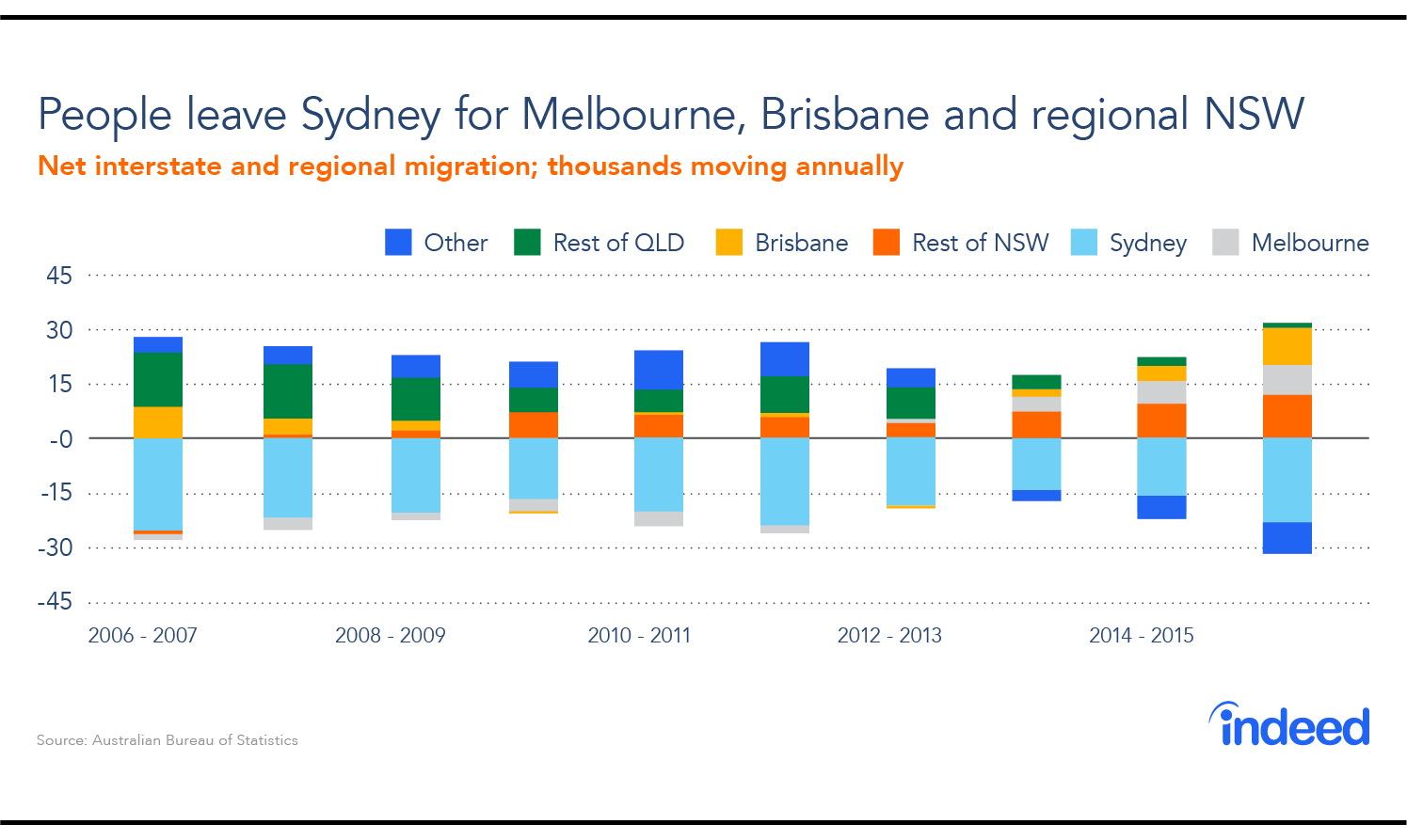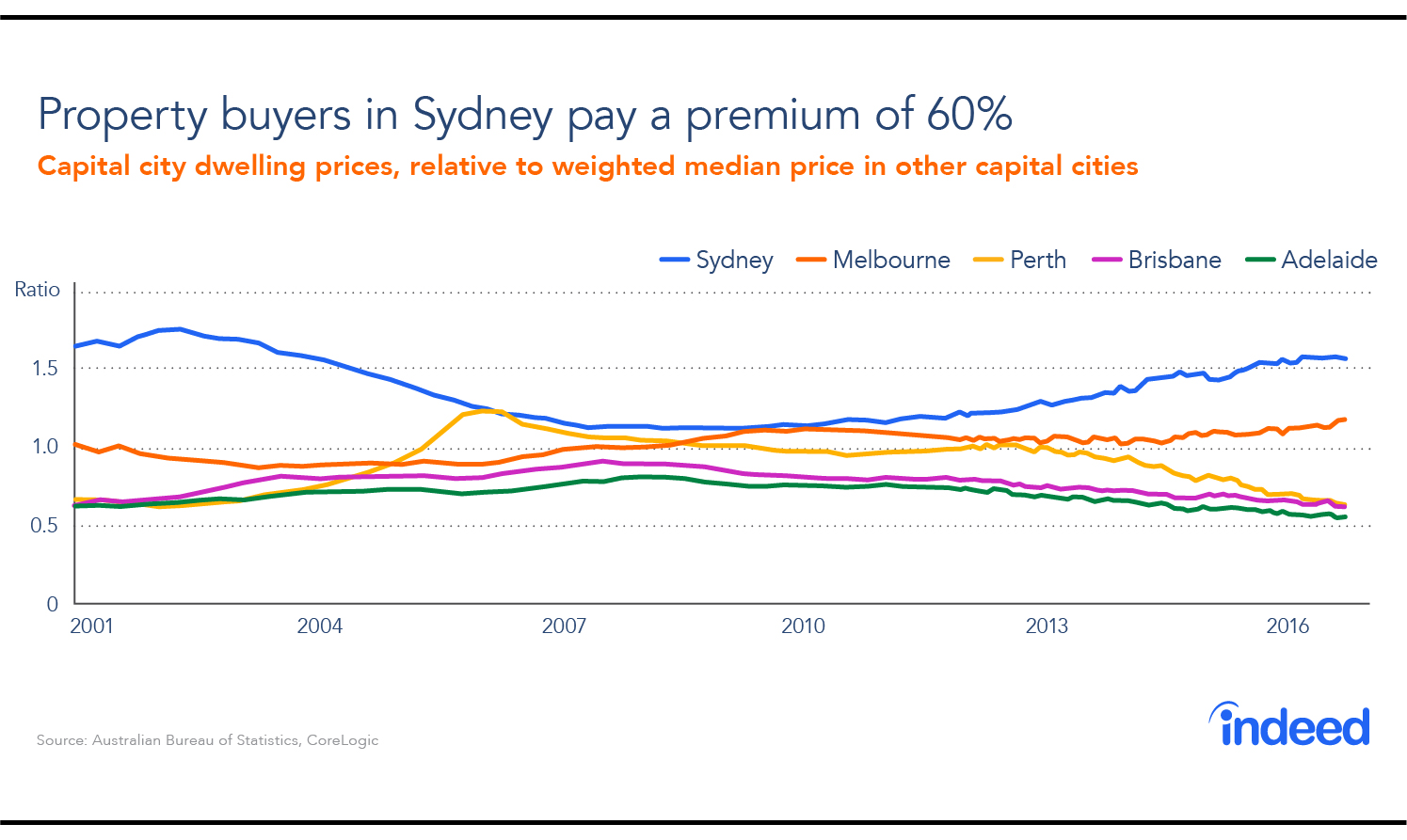Sydney is the economic capital of Australia—a cosmopolitan metropolis known for its beaches, its beauty and its nightlife. Yet many highly skilled workers would rather live someplace else. In fact, Sydney may be facing a brain drain and its position as Australia’s central technology hub could be in jeopardy.
Despite a strong state economy and plenty of job opportunities, data show that a high proportion of Sydneysiders are actively looking for jobs elsewhere, including those with some of the skills most needed in a competitive economy.
For starters, more people are leaving Sydney than are moving in. Around 93,000 Sydneysiders migrated either interstate or to regional New South Wales in the 2015–16 financial year, according to the Australian Bureau of Statistics. Only 70,000 people moved the other way.
Indeed data suggests that this outflow includes highly skilled workers that Sydney cannot afford to lose. Around 9% of clicks by STEM (science, technology, engineering and mathematics) job seekers in New South Wales are outbound, that is, for jobs posted in other states. By comparison, only 6% of clicks for New South Wales STEM job postings are inbound, coming from job seekers living in other states. With the exception of South Australia, STEM job seekers in New South Wales are the most likely group to search for work interstate.
To be sure, while search and click behaviour is a sign that job seekers may be considering an interstate move, it doesn’t mean that a move will actually be made. Although 8% of clicks from all job seekers in New South Wales in 2016 were for interstate job postings, only 1.4% of people in New South Wales actually moved to another state. But click behavior is a measure of job seeker sentiment and it offers insights into how those looking for work view the market.
Why is Sydney losing its attractiveness to job seekers? We don’t know for certain. But one reason might be Sydney’s expensive property market, which creates a powerful incentive to seek work elsewhere.
The chart below shows net interstate and regional migration in Australia. In 2015–16, Sydney’s interstate and regional exodus was at its highest level since the 2011–12 financial year. The biggest gainers were regional New South Wales, Melbourne and Brisbane.

Interstate search behaviour in Australia
Indeed data show that high- and low-skilled workers in New South Wales explore interstate job opportunities at roughly the same rate. In other words, although a brain drain is occurring, the reasons for leaving Sydney are not specific to one group, but apply to job seekers across the skills spectrum.
Among Australian job seekers at all skill levels, those from New South Wales and South Australia are most likely to look for work interstate. When they do, they gravitate toward Victoria and Queensland.
Around 8% of clicks from all job seekers in New South Wales are for job postings outside New South Wales, while only 5% of clicks from all job seekers elsewhere are for jobs in New South Wales. By comparison, Queensland has a lower level of outbound clicks and a higher level of inbound clicks, which would be expected from a state experiencing positive interstate migration.

Where are STEM job seekers searching?
Indeed data show state differences in STEM job search behaviour. As noted earlier, 6% of clicks for New South Wales STEM job postings come from out-of-state job seekers. By contrast, the rate of interstate clicks for STEM job postings is 8% in Victoria and 12% in Queensland.

STEM workers are in high demand nationwide and have considerable choice about where to live and work. Increasingly, these workers are deciding not to live in Sydney and are heading for places like Melbourne and Brisbane. That may be putting Sydney’s dominant position in technology at risk.
What’s Driving Interstate Migration?
The factors driving interstate migration are many and varied. Of course, some are place specific. For example, Sydney is often the first destination for immigrants coming to Australia, though many eventually settle elsewhere. The Economist has ranked Melbourne as the world’s most livable city seven years in a row. Queensland’s weather has been described as beautiful one day and perfect the next, which has prompted many a southerner to pack their bags and head north.
Broadly speaking though, Australian interstate migration trends reflect two primary factors: economic opportunity and living costs.
On the first count, New South Wales and Victoria come in strong. The two states have had Australia’s best performing economies, driving the country’s post-mining economic transition and accounting for around three-quarters of employment growth over the past four years. Indeed data shows employment opportunities remain high in both states, which will continue to draw job seekers from elsewhere.
On the second count though, Sydney is at a decided disadvantage. Living costs appear to have pushed people out of Sydney during the early 2000s and history may be repeating itself. Currently, Sydney housing fetches a 60% premium compared with the median price across other state capital cities. A buyer in Sydney can expect to pay more than double what it would cost to get a similar property in Brisbane, Adelaide or Perth.

Unfortunately, Sydneysiders are not compensated for these higher living costs. Full-time workers in New South Wales earn less than full-time workers in Western Australia and only a little more than those living in Victoria and Queensland. The interstate migration numbers suggest that high property prices are prompting job seekers to move elsewhere, counteracting the effects of a relatively strong economy.
Despite the internal migration trends, there’s no need to shed a tear for Sydney—at least just yet. Australia’s great metropolis remains a magnet for overseas job seekers and New South Wales attracts more foreign migrants than any other state. But, for job seekers open to a big move—particularly those with STEM skills—Sydney increasingly is losing its allure, while Melbourne and Brisbane shine.
Methodology:
Data on capital city and regional migration is from the Australian Bureau of Statistics (ABS). This post focuses on state-level migration because of comparability with Indeed data. Since each state capital city accounts for a high share of total state population, state-level trends are generally consistent with capital city trends.
